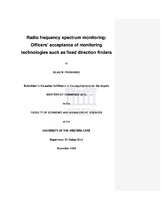| dc.contributor.advisor | Smit, Kobus | |
| dc.contributor.author | Phoshoko, Silas M. | |
| dc.contributor.other | NULL | |
| dc.contributor.other | Faculty of Economics and Management Sciences | |
| dc.date.accessioned | 2013-10-18T14:02:41Z | |
| dc.date.available | 2009/10/22 10:09 | |
| dc.date.available | 2009/10/22 | |
| dc.date.available | 2013-10-18T14:02:41Z | |
| dc.date.issued | 2006 | |
| dc.identifier.uri | http://hdl.handle.net/11394/2299 | |
| dc.description | Magister Commercii - MCom | en_US |
| dc.description.abstract | The research focuses on the acceptance of new technologies within the telecommunications industry. The study examines three models namely Innovation theory, Theory of Reason Action (TRA), and Technology Acceptance Model (TAM). This study explores the technology acceptance models in order to explain why certain monitoring officers at ICASA would prefer specific technologies over others. Models of interest could be the innovation theory, TRA and TAM. After reviewing both models, the author will examine the TAM in detail as a model of interest in this study. In turn, this model is expected to assist us to understand why monitoring officer's at ICASA would prefer a particular frequency monitoring technology over the other. | en_US |
| dc.language.iso | en | en_US |
| dc.publisher | University of the Western Cape | en_US |
| dc.subject | Technology Acceptance Model (TAM) | en_US |
| dc.subject | Independent Communication Authority of South Africa (ICASA) | en_US |
| dc.subject | Fixed Direction Finder (FDF) | en_US |
| dc.subject | Remote sites antenna mast | en_US |
| dc.subject | Mobile monitoring unit | en_US |
| dc.subject | Perceived usefulness | en_US |
| dc.subject | Perceived ease of use | en_US |
| dc.subject | Perceived enjoyment | en_US |
| dc.subject | Attitude towards use | en_US |
| dc.subject | Intention to use | en_US |
| dc.title | Radio frequency spectrum monitoring: Officers' acceptance of monitoring technologies such as fixed direction finders | en_US |
| dc.type | Thesis | en_US |
| dc.rights.holder | University of the Western Cape | en_US |
| dc.description.country | South Africa | |

